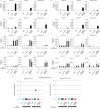A novel bivalent vaccine based on a PB2-knockout influenza virus protects mice from pandemic H1N1 and highly pathogenic H5N1 virus challenges
- PMID: 23658445
- PMCID: PMC3700221
- DOI: 10.1128/JVI.00076-13
A novel bivalent vaccine based on a PB2-knockout influenza virus protects mice from pandemic H1N1 and highly pathogenic H5N1 virus challenges
Abstract
Vaccination is an effective means to protect against influenza virus. Although inactivated and live-attenuated vaccines are currently available, each vaccine has disadvantages (e.g., immunogenicity and safety issues). To overcome these problems, we previously developed a replication-incompetent PB2-knockout (PB2-KO) influenza virus that replicates only in PB2 protein-expressing cells. Here, we generated two PB2-KO viruses whose PB2-coding regions were replaced with the HA genes of either A/California/04/2009 (H1N1pdm09) or A/Vietnam/1203/2004 (H5N1). The resultant viruses comparably, or in some cases more efficiently, induced virus-specific antibodies in the serum, nasal wash, and bronchoalveolar lavage fluid of mice relative to a conventional formalin-inactivated vaccine. Furthermore, mice immunized with these PB2-KO viruses were protected from lethal challenges with not only the backbone virus strain but also strains from which their foreign HAs originated, indicating that PB2-KO viruses with antigenically different HAs could serve as bivalent influenza vaccines.
Figures






Similar articles
-
Evaluation of seasonal influenza vaccines for H1N1pdm09 and type B viruses based on a replication-incompetent PB2-KO virus.Vaccine. 2017 Apr 4;35(15):1892-1897. doi: 10.1016/j.vaccine.2017.02.041. Epub 2017 Mar 9. Vaccine. 2017. PMID: 28285982
-
Live attenuated influenza viruses containing NS1 truncations as vaccine candidates against H5N1 highly pathogenic avian influenza.J Virol. 2009 Feb;83(4):1742-53. doi: 10.1128/JVI.01920-08. Epub 2008 Dec 10. J Virol. 2009. PMID: 19073731 Free PMC article.
-
Optimized clade 2.3.2.1c H5N1 recombinant-vaccine strains against highly pathogenic avian influenza.J Vet Sci. 2017 Aug 31;18(S1):299-306. doi: 10.4142/jvs.2017.18.S1.299. J Vet Sci. 2017. PMID: 28859269 Free PMC article.
-
M2SR, a novel live influenza vaccine, protects mice and ferrets against highly pathogenic avian influenza.Vaccine. 2017 Jul 24;35(33):4177-4183. doi: 10.1016/j.vaccine.2017.06.039. Epub 2017 Jun 28. Vaccine. 2017. PMID: 28668565 Free PMC article.
-
A replication-incompetent PB2-knockout influenza A virus vaccine vector.J Virol. 2012 Apr;86(8):4123-8. doi: 10.1128/JVI.06232-11. Epub 2012 Feb 1. J Virol. 2012. PMID: 22301144 Free PMC article.
Cited by
-
Development of a novel equine influenza virus live-attenuated vaccine.Virology. 2018 Mar;516:76-85. doi: 10.1016/j.virol.2018.01.005. Epub 2018 Jan 11. Virology. 2018. PMID: 29331866 Free PMC article.
-
Comparative Study of the Temperature Sensitive, Cold Adapted and Attenuated Mutations Present in the Master Donor Viruses of the Two Commercial Human Live Attenuated Influenza Vaccines.Viruses. 2019 Oct 10;11(10):928. doi: 10.3390/v11100928. Viruses. 2019. PMID: 31658679 Free PMC article.
-
A Bivalent Vaccine Based on a PB2-Knockout Influenza Virus Protects Mice From Secondary Pneumococcal Pneumonia.J Infect Dis. 2015 Dec 15;212(12):1939-48. doi: 10.1093/infdis/jiv341. Epub 2015 Jun 29. J Infect Dis. 2015. PMID: 26123562 Free PMC article.
-
Development and applications of single-cycle infectious influenza A virus (sciIAV).Virus Res. 2016 May 2;216:26-40. doi: 10.1016/j.virusres.2015.07.013. Epub 2015 Jul 26. Virus Res. 2016. PMID: 26220478 Free PMC article. Review.
-
Hemozoin as a novel adjuvant for inactivated whole virion influenza vaccine.Vaccine. 2014 Sep 15;32(41):5295-300. doi: 10.1016/j.vaccine.2014.07.079. Epub 2014 Aug 6. Vaccine. 2014. PMID: 25108216 Free PMC article.
References
-
- van der Wouden JC, Bueving HJ, Poole P. 2005. Preventing influenza: an overview of systematic reviews. Respir. Med. 99:1341–1349 - PubMed
-
- Nabel GJ, Fauci AS. 2010. Induction of unnatural immunity: prospects for a broadly protective universal influenza vaccine. Nat. Med. 16:1389–1391 - PubMed
-
- Lambert LC, Fauci AS. 2010. Influenza vaccines for the future. N. Engl. J. Med. 363:2036–2044 - PubMed
-
- Girard MP, Katz J, Pervikov Y, Palkonyay L, Kieny MP. 2010. Report of the 6th meeting on the evaluation of pandemic influenza vaccines in clinical trials World Health Organization, Geneva, Switzerland, 17–18 February 2010. Vaccine 28:6811–6820 - PubMed
-
- Cox RJ, Brokstad KA, Ogra P. 2004. Influenza virus: immunity and vaccination strategies. Comparison of the immune response to inactivated and live, attenuated influenza vaccines. Scand. J. Immunol. 59:1–15 - PubMed
Publication types
MeSH terms
Substances
Grants and funding
LinkOut - more resources
Full Text Sources
Other Literature Sources
Medical
Research Materials

